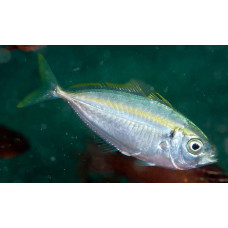Carangidae is a family of fishes in the order Perciformes. The first dorsal fin is barbed, the second consists of soft rays. The lateral line makes a bend above the pectoral fins, sometimes armed with bony shields. The caudal peduncle is thin. Tropical, subtropical and temperate waters of the Atlantic, Indian and Pacific Oceans. Marine, mainly pelagic social fish. Known in more than 30 genera (mackerel, yellowtail, pilot whale, etc.), about 200 species. They lay pelagic eggs. Most species feed on zooplankton or small fish. Length from 40 to 100 cm. Important commercial fish. Some species of mackerel are subject to mariculture (yellowtail).
Members of the family usually have a compressed body at the sides, although the shape can vary greatly. They have two dorsal fins. The first dorsal fin has 3-9 barbed rays, the second, longer, has 18-37 soft rays. Spiny bony plates often protrude along the lateral line. The caudal fin is broadly forked. Some species have one or more additional fins behind the second dorsal and anal fins. In front of the anal fin there are two separate barbs, sometimes connected to each other or to the fin by ligaments (sometimes they can be hidden under the skin). The caudal peduncle is thin. The family comprises more than 20 genera with 200 species of marine fishes found in tropical, subtropical and temperate waters of the Atlantic, Indian and Pacific Oceans and adjacent seas. Many Carangidae are large fish that are important in commercial fisheries.
Fast predators that live between reefs and in the open ocean. Some feed on benthic invertebrates. Often gregarious.
Carangidae
Tags: carangidae



